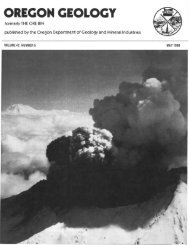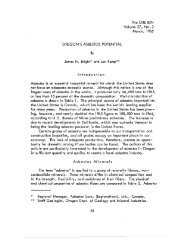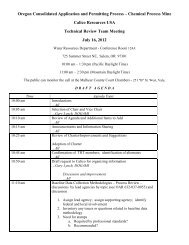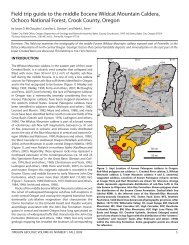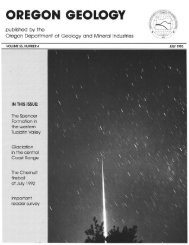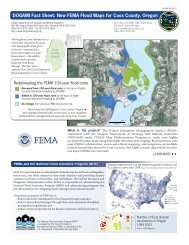What is a tsunami? - Oregon Department of Geology and Mineral ...
What is a tsunami? - Oregon Department of Geology and Mineral ...
What is a tsunami? - Oregon Department of Geology and Mineral ...
Create successful ePaper yourself
Turn your PDF publications into a flip-book with our unique Google optimized e-Paper software.
what to do<br />
At the coast, whether you are a<br />
resident or v<strong>is</strong>itor, you need to<br />
know where to find high ground<br />
in case <strong>of</strong> a <strong>tsunami</strong>. Make it your<br />
personal responsibility to be<br />
prepared: at work, home <strong>and</strong> play.<br />
Get an evacuation map for your<br />
area or go online to<br />
<strong>Oregon</strong>Tsunami.org to find one.<br />
Talk to local emergency <strong>of</strong>ficials<br />
(fire, police, Red Cross) about<br />
evacuation routes <strong>and</strong> assembly<br />
areas.<br />
If you’re inside <strong>and</strong> you feel the ground shake,<br />
drop, cover <strong>and</strong> hold on. If outside, move to an<br />
open area <strong>and</strong> watch for falling objects.<br />
F<br />
or ideas on how to make an emergency<br />
plan, how to put together a grab & go kit,<br />
<strong>and</strong> what to do in case <strong>of</strong> a large <strong>of</strong>fshore<br />
earthquake <strong>and</strong> <strong>tsunami</strong>, your best source <strong>of</strong><br />
information <strong>is</strong> the people in your own<br />
backyard. Remember, your emergency plan<br />
<strong>and</strong> preparations will directly determine how<br />
well you cope with any type <strong>of</strong> natural d<strong>is</strong>aster.<br />
Other Resources<br />
<strong>Oregon</strong> <strong>Department</strong> <strong>of</strong> <strong>Geology</strong> <strong>and</strong> <strong>Mineral</strong><br />
Industries (DOGAMI)<br />
(971) 673-1555<br />
http://www.<strong>Oregon</strong>Tsunami.org<br />
<strong>Oregon</strong> Emergency Management (OEM)<br />
(503) 378-2911 ext. 22237<br />
http://www.oregon.gov/OMD/OEM<br />
<strong>Oregon</strong> Pacific Chapter<br />
<strong>of</strong> the American Red Cross (ARC)<br />
(541) 673-3255<br />
www.oregonpacific.redcross.org<br />
National Tsunami Hazard Mitigation Program<br />
(NTHMP)<br />
http://nthmp.<strong>tsunami</strong>.gov/<br />
TSUNAMI!<br />
know<br />
what to do<br />
on the<br />
<strong>Oregon</strong><br />
coast<br />
Do not wait for a warning if you are in a low lying<br />
area. Do not pack or delay. Immediately locate<br />
your grab & go kit. Evacuate on foot. Move inl<strong>and</strong><br />
to high ground. Try to get 100 feet above sea<br />
level.<br />
Do not return to shore after the first wave. More<br />
waves may be coming, even many hours later.<br />
www.<strong>Oregon</strong>Tsunami.org<br />
Tsunami Outreach <strong>Oregon</strong> <strong>is</strong> local communities working<br />
together on earthquake <strong>and</strong> <strong>tsunami</strong> preparedness. The program<br />
<strong>is</strong> funded by the NOAA National Tsunami Hazard Mitigation<br />
Program <strong>and</strong> <strong>is</strong> admin<strong>is</strong>tered by The <strong>Oregon</strong> <strong>Department</strong> <strong>of</strong><br />
<strong>Geology</strong> <strong>and</strong> <strong>Mineral</strong> Industries, in partnership with <strong>Oregon</strong><br />
Emergency Management.
<strong>What</strong> <strong>is</strong> a<br />
<strong>tsunami</strong>?<br />
A <strong>tsunami</strong> (su-NAH-mee) <strong>is</strong> a<br />
series <strong>of</strong> sea waves usually caused<br />
by the sudden movement <strong>of</strong> the<br />
ocean floor because <strong>of</strong> a large<br />
undersea earthquake. As tsunam<strong>is</strong><br />
enter shallow water near l<strong>and</strong>, they<br />
increase in height <strong>and</strong> can cause great<br />
loss <strong>of</strong> life <strong>and</strong> property damage.<br />
People on open beaches, low-lying areas, by<br />
bays or tidal flats, <strong>and</strong> near mouths <strong>of</strong> rivers<br />
draining into the ocean are at greatest r<strong>is</strong>k from<br />
a <strong>tsunami</strong> <strong>and</strong> may have little time after a large<br />
earthquake to move to high ground.<br />
Tsunam<strong>is</strong> can<br />
happen at any time<br />
In March 2011 on a Friday afternoon at<br />
2:46pm, a magnitude 9 megathrust earthquake<br />
occurred 80 miles <strong>of</strong>f the coast <strong>of</strong> Japan.<br />
D<strong>is</strong>placed ocean <strong>tsunami</strong> waves began<br />
inundating the coast within 15 minutes, with<br />
waves ranging up to 35 feet high <strong>and</strong> reaching<br />
run-up elevations <strong>of</strong> 135 feet. 15,845 people<br />
died <strong>and</strong> 3,380 are still m<strong>is</strong>sing. The same thing<br />
could happen on our coast at any time <strong>and</strong> be<br />
just as deadly.<br />
Learn about the <strong>tsunami</strong><br />
warning system <strong>and</strong> where<br />
to find evacuation maps at:<br />
www.<strong>Oregon</strong>Tsunami.org<br />
2 types <strong>of</strong> tsunam<strong>is</strong>:<br />
know the difference<br />
A DISTANT TSUNAMI, caused by a large<br />
undersea earthquake, comes from across the<br />
ocean <strong>and</strong> will take at least a few hours to<br />
come ashore. There will usually be plenty <strong>of</strong><br />
time for an <strong>of</strong>ficial warning <strong>and</strong> evacuation, if<br />
necessary. A NOAA weather radio <strong>is</strong> the best<br />
way to find out what <strong>is</strong> happening. Many communities also<br />
have sirens <strong>and</strong> mass calling systems to alert the public.<br />
Designated local radio <strong>and</strong> TV stations will also have<br />
information through their Emergency Alert System (EAS).<br />
A LOCAL TSUNAMI comes ashore within 10 to 20<br />
minutes after a nearby <strong>of</strong>fshore earthquake that you will<br />
feel. A local <strong>tsunami</strong> can be very destructive <strong>and</strong> fatal. Do<br />
not wait for a warning. If you are near the ocean, you<br />
need to head to high ground as quickly as possible. Your<br />
only warning will be the ground shaking. It’s important to<br />
have a grab & go kit <strong>and</strong> know the evacuation routes <strong>and</strong><br />
assembly areas in your community.<br />
See more at: www.<strong>Oregon</strong>Tsunami.org<br />
Learn the facts, make a plan<br />
<strong>and</strong> get some help<br />
Underst<strong>and</strong>ing what could happen in a great earthquake <strong>and</strong> <strong>tsunami</strong> <strong>and</strong> how<br />
<strong>of</strong>ten they occur <strong>is</strong> the first step toward being prepared. You’ll realize you need<br />
a plan for anything Mother Nature can throw at you, not just “The Big One.”<br />
There are dedicated people in your area that can help you get started with an<br />
emergency plan <strong>and</strong> with putting together a grab & go, or d<strong>is</strong>aster kit. You can<br />
also join a Map Your Neighborhood group in your area, take a Red Cross class<br />
or a local Community Emergency Response Team (CERT) training class. The<br />
agencies l<strong>is</strong>ted on the back <strong>of</strong> th<strong>is</strong> brochure are resources that can answer<br />
questions, provide information <strong>and</strong> get you started. After all, we’ll be helping<br />
each other when a d<strong>is</strong>aster happens.





